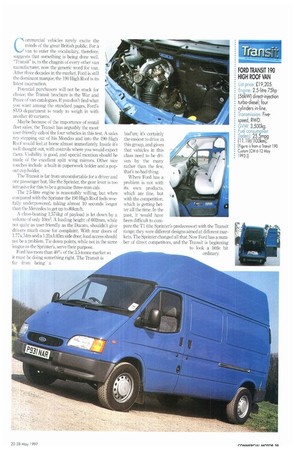T he Iveco Daily range is divided into three sections with
Page 40

Page 41

If you've noticed an error in this article please click here to report it so we can fix it.
the 35.10 Daily Classic sitting right in the middle. Iveco vans have traditionally found favour with operators who demand durability and competitive prices. The "New" Daily, launched a year ago, continues this theme—the 35.10 is certainly a chunky beast; not the sort of van you'd want to fall out with.
Durability and a low price are laudable aims, but when it comes to cab comfort the 35.10 is functional rather than comfortable. This is not a problem for local work, but watch out for sick notes if you threaten a Daily driver with a long-haul trip.
That aside, the design of the cab is perfectly acceptable. The dashboard layout is reasonable and, with the exception of the irritating separate column stalk for main and dipped beam, the driving environment does not generally offend. The Daily handles well and the all-round disc brakes deserve praise.
Sadly that does not hold true for the gearbox or handbrake. The former, with its dog-leg first, is to put it kind ly, "proven technology". The shift is stiff and unwieldy, which is particularly unfortunate on a 3.5-tonner which should be driveable by relative novices. Similarly, the handbrake is set so low as to threaten the driver with a dose of the bends should he apply it too quickly: handbrake travel should be measured in inches rather than atmospheres, and we hope that Iveco will address this problem in the near future.
To be fair, these shortcomings begin to fade when set against the 35.10's productivity potential. Its loading height of 775mm is high and at 1,275kg its payload is 5kg less than the Sprinter's—and 225kg less than the Ducato's. However, with vans tending to cube out before they weigh out, volume is probably a more important limitation than payload, and at 12.3m3 the 35.10 is beaten only by the Sprinter. Moreover, in the resilience stakes, it stands head and shoulders above the rest: bombproof is the adjective that comes to mind.
If you are in the market for a long-haul van, or if comfort is at the top of your agenda, forget the Daily. But if your operation demands a big volume vehicle that can thrive in a tough environment, then the Daily has a lot going for it. As a good, honest, no-frills workhorse, the 35.10 is up with the leaders.
Commercial vehicles rarely excite the minds of the great British public. For a van to enter the vocabulary, therefore, suggests that something is being done well. "Transit." is, to the chagrin of every other van manufacturer, now the generic word for van. After three decades in the market. Ford is still the dominant marque; the 190 High Roof is its latest incarnation.
Potential purchasers will not be stuck for choice: the Transit brochure is the War and Peace of van catalogues. If you don't find what you want among the standard pages. Ford's SVO department is ready to weigh in with another 40 variants.
11 laybe because of the importance of rental fleet sales, the Transit has arguably the most user-friendly cab of the four vehicles in this test. A sales rep stepping out of his Mondeo and into the 190 High Roof would feel at home almost immediately. Inside it well thought out, with controls where you would expect them. Visibility is good, and special mention should be made of the excellent split wing mirrors. Other nice touches include a built-in paperwork holder and a popout cup holder.
The Transit is far from uncomfortable for a driver and one passenger but, like the Sprinter, the gear lever is too intrusive for this to be a genuine three-man cab.
The 2.5-litre engine is reasonably willing, but when compared with the Sprinter the 190 High Roof feels woefully underpowered, taking almost 10 seconds longer than the Mercedes to get up to 80km/h.
.A class-beating 1,574kg of payload is let down by a volume of only 10m3. A loading height of 602mm, while not quite as user-friendly as the Ducato, shouldn't give drivers much cause for complaint. With rear doors of 1.77x.54m and a 1.25x1.03m side door, load access should not be a problem. Tie down points, while not in the same league as the Sprinter's, serve their purpose.
Ford has more than 40% of the 3.5-tonne market so it must be doing something right. The Transit is far from being a bad'un; it's certainly the easiest to drive in this group, and given that vehicles in this class need to be driven by the many rather than the few. that's no bad thing Where Ford has a problem is not with its own products, which are fine, but with the competition, which is getting better all the time. In the past, it would have been difficult to compare the Ti (the Sprinter's predecessor) with the Transit range; they were different designs aimed at different markets. The Sprinter changed all that. Now Ford has a number of direct competitors, and the Transit is beginning to look a little bit ordinary.
















































































































